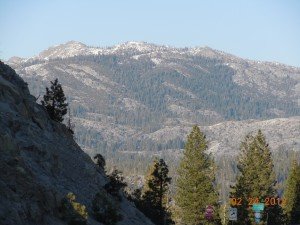
California Gold Country is a destination for many travelers to the Golden State. The area in the foothills of the Sierra Nevada Mountains just east of Sacramento was the hub of activity during that crucial period when the region was taken over by the U.S, during the late 1840’s. Gold Country in California today is filled with reminders of the time that the gold fields were the destination of gold prospectors from all over the globe. People flocked there by any means possible. The fact that a journey to California usually meant either an ocean voyage around Cape Horn or through the Isthmus of Panama, neither an easy journey.
One reminder of the gold rush days are some of the very historic hotels, some of which are still operating, each with it’s own unique stories to tell.
Gold Country in California is all about nineteenth century history and we have highlighted a few of the historic hotels which would make great additions to your California vacation planner.
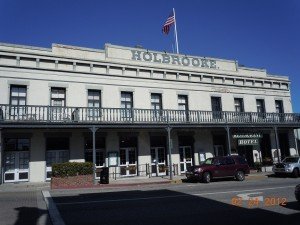
Holbrooke Hotel
The Holbrooke Hotel is located in beautiful Grass Valley California. This very historic Victorian hotel’s early visitors included U.S. Presidents Ulysses S. Grant, Grover Cleveland and Benjamin Harrison. Others notables who spent some time there included none other than Mark Twain, Jim Corbett, the theatrical star Lotta Crabtree and many more. The hotel burned down in the huge fire of 1855 but was rebuilt in 1862. Today, the Holbrooke Hotel features an elegant dining room, an interesting and historic bar and an antique elevator that still operates. The hotel has twenty-seven rooms and is a California Historic Landmark. Grass Valley, located on CA Hwy 49, is a 60 mile drive east of Sacramento California.
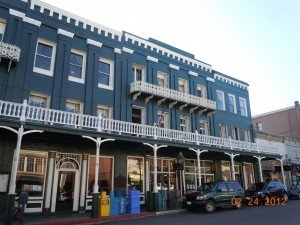
National Hotel
The National Hotel is located in Nevada City California, not far up the road from Grass Valley. The National Hotel is listed on the National Register of Historic Places.
The National Hotel is the most historic of all old Nevada City California. Before being named the National Hotel, the structure opened in August of 1856 under the name of “Bicknell Block“. The Bicknell Block housed just about everything of major importance during the early days. The stagecoach stop, post office and telegraph office. Nevada City’s National Hotel is considered one of the oldest hotels west of the Rocky Mountains that has been in continuous operation. When you step inside it’s like a trip back to the Victorian era. The hotel is the site of California Historic Landmark No. 899 and is the most well known of the old hotels in the California gold country.
A link to another interesting story you’ll enjoy about Nevada City California and the National Hotel is our article about the notorious female gambling hall operator, Madame Mustache. Nevada City is located on CA Hwy 49 about 64 miles east of Sacramento California.
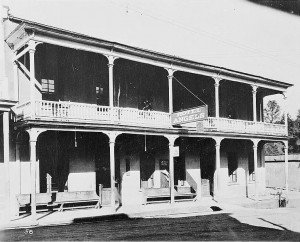
The Angels Hotel
The Angels Hotel, which actually started out as a canvas tent, is located in Angels Camp California, one of the many very historic old gold mining towns. The most famous story that came out the The Angels Hotel involved Mark Twain. It seems that Twain overheard a story while staying at the hotel which he later turned into the hugely popular story of “The Celebrated Jumping Frog of Calaveras County“. In fact, this short story, also eventually made into an opera, is what catapulted Mark Twain (Samuel Clemens) into the national spotlight.
Angels Camp California today has the motto of “Home of the Jumping Frog“. The Angels Hotel no longer operates but is a California Historic Landmark and is on the National Register of Historic Places. Angels Camp is located on CA Hwy 49 about 80 miles southeast of Sacramento California.
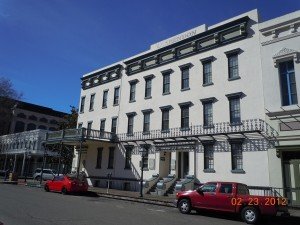
The Clarendon House
Old Town Sacramento came about as a direct result of the booming mining operations in the nearby California gold fields. Sacramento California served as a hub for steamboat traffic which ferried passengers between San Francisco and the gold fields. Sacramento was the jumping off point for prospectors and served as the commerce center for supplies, mail and entertainment.
The Clarendon House, once a Sacramento hotel, and now a National Historic Landmark, has now been turned into a residential building offering laundry facilities onsite, garage parking and controlled access entry. The bottom level of the building now houses eight commercial spaces. The structure located in Old Town Sacramento is among the fifty-three historic buildings still in existence. The present three-story building was constructed in 1977 to replicate the authentic 1852 exterior.
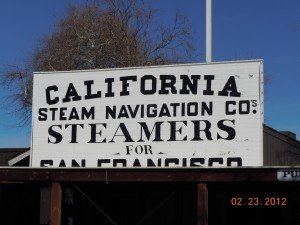
Two links to articles you’ll also enjoy on our Trips Into History site include the Story of the Eagle Theater in Old Town Sacramento which was actually washed away by a flood during the middle of a performance.
Another interesting article is about the Leland Stanford Mansion in downtown Sacramento CA.
Old Town Sacramento itself makes a great addition to your northern California vacation planner. In addition to the historic structures like The Clarendon House, you’ll be able to visit the California State Railroad Museum, one of the finest railroad museums in the world, a restored Wells Fargo office which now serves as a museum as well as a host of other structures dating back to the California gold rush era.
Gold Country in California makes for a fascinating, fun and educational destination and is ideal for a family vacation or weekend getaway.
(Undated photo of the Angels Hotel is from the public domain. Remainder of photos are from the author’s private collection)
